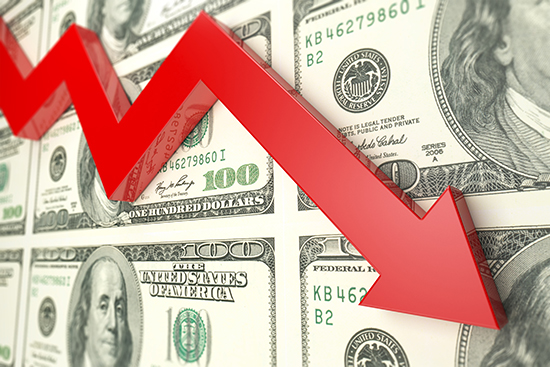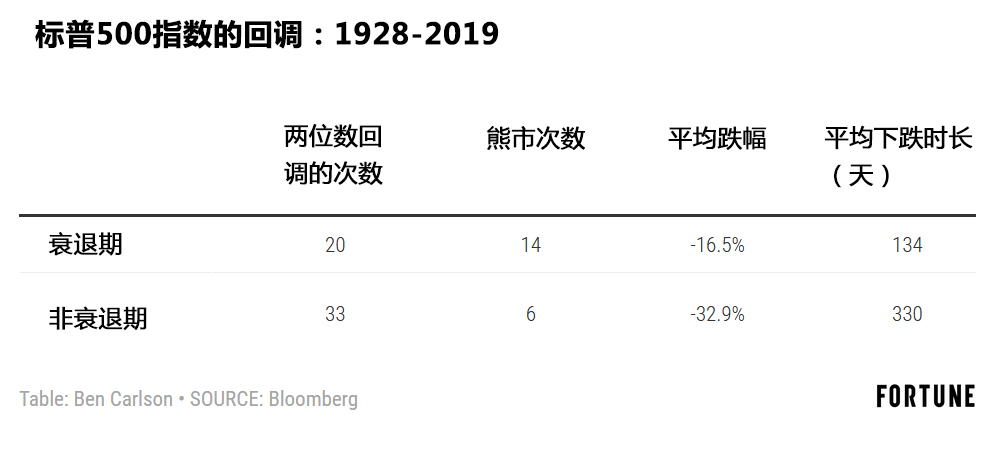在股市中尋找入手時機?別苦苦地等待經(jīng)濟衰退了

|
摩根士丹利(Morgan Stanley)的策略師邁克·威爾遜最近向美國全國廣播公司財經(jīng)頻道(CNBC)表示,他在期待經(jīng)濟衰退讓股市重新歸零。威爾遜在《The Halftime Report》節(jié)目中說:“我在某種程度上期待經(jīng)濟衰退,因為衰退早晚會來,而衰退在某種程度上可以滿足人們的期望。然后我們就會迎來周期性復蘇。” 自2009年3月初金融危機觸底以來,美國股市盡管出現(xiàn)了不少次回調(diào),但一直持續(xù)上漲。據(jù)我計算,自2009年以來,標普500指數(shù)已經(jīng)出現(xiàn)了6次兩位數(shù)的回調(diào),其中2018年第四季度的跌幅最大,達到19%。但V型復蘇速度很快,目前還沒有再次遭遇崩盤。隨著市場持續(xù)推高,許多投資者都在觀望,等待資本重新配置的機會。 許多投資者認同威爾遜的觀點,即經(jīng)濟衰退是許多人一直等待的唯一買入機會。經(jīng)濟衰退是我們經(jīng)濟體系產(chǎn)生的自然結(jié)果,所以它們永遠不會消失,但你不必為了找到更好的入市時機期待經(jīng)濟衰退。在經(jīng)濟衰退之外,投資者總有各種各樣的原因產(chǎn)生過度反應,導致股票價格下降。 如果我們回顧一下1928年以來的標普500指數(shù),會發(fā)現(xiàn)總共出現(xiàn)了53次兩位數(shù)的回調(diào)。在過去的91年里,大約每一年半就有一次。在這53次兩位數(shù)的下調(diào)中,有20次跌幅都超過20%,符合熊市的標準定義。也就是說,平均每四年半就會出現(xiàn)一次熊市。 但在這53次兩位數(shù)的下調(diào)中,有33次發(fā)生在經(jīng)濟衰退之外。20次熊市中有6次出現(xiàn)在經(jīng)濟衰退之外。也就是說,60%的兩位數(shù)下跌和30%的熊市都是在沒有出現(xiàn)衰退的情況下發(fā)生的。 1987年的“黑色星期一”股市崩盤就是最極端的例子。1987年10月,股市單日跌幅超過20%,周跌幅超過30%,許多經(jīng)濟學家擔心當時已經(jīng)處于瀕臨大蕭條的邊緣。結(jié)果,這只不過是20世紀八九十年代股市長期上行軌跡上的一個小插曲。 之后的五年里,沒有經(jīng)濟衰退,標普500指數(shù)上漲超過120%,年回報率達到驚人的17%。大多數(shù)人都忘記了,盡管那次股市暴跌史無前例,當年的標普500指數(shù)收盤仍然上漲了5%左右。 看看在經(jīng)濟衰退中和經(jīng)濟衰退外出現(xiàn)的股市下跌之間有區(qū)別也很有意義。 |
Morgan Stanley strategist Mike Wilson told CNBC recently that he’s rooting for a recession to get a reset in the stock market. Wilson told The Halftime Report, “I’m rooting for a recession in some ways because that’s what would get the flush in terms of expectations that still has to happen. And then we can have a cyclical recovery.” Although there have been a number of corrections along the way, the stock market has been in a relentless rise since the bottom of the Great Financial Crisis crash in early-March of 2009. By my count there have been six double-digit corrections in the S&P 500 since 2009, with the largest losses coming in the 4th quarter of 2018 at 19% and change. But the V-shaped recoveries have been swift and we haven’t gotten another crash. That’s left many investors waiting to redeploy capital they’ve been sitting on as the market continues to push ever higher. Many investors share Wilson’s belief that a recession is the only way to get that buying opportunity so many have been waiting for. Recessions are a natural outcome of our economic system so they’re never going away but you don’t have to root for an economic downturn to find better entry points in the stock market. Investors have always found other ways of overreacting outside of a recession to make stocks cheaper. If we look at the S&P 500 going back to 1928, there have been 53 double-digit corrections. That’s roughly one every year-and-a-half or so over the past 91 years. Of those 53 double-digit losses, 20 times stocks have fallen by the standard bear market definition of losses in excess of 20%. So bear markets have happened once every four-and-a-half years, on average. But 33 of those 53 double-digit drawdowns occurred outside of a recession. And 6 out of the 20 bear markets took place outside of an economic downturn. So more than 60% of all double-digit corrections and 30% of all bear markets took place without the onset of a recession. The 1987 Black Monday crash is the most extreme example. After the stock market fell more than 20% on a single day and more than 30% over the course of a week in October 1987, many economists were worried we were on the brink of a depression. It turned out to be nothing but a blip on the long-term upward trajectory of the stock market throughout the 1980s and 1990s. There was no recession and the S&P 500 would go on to gain more than 120% over the ensuing 5 years for an annual return of an astounding 17%. Most people fail to remember that although that crash was unprecedented, the S&P 500 still finished the year up around 5%. It’s also instructive to look at the differences in the drawdowns which take place in the context of a recession and outside of those periods. |

|
很明顯,當經(jīng)濟陷入衰退時,股市會更加失控。股市下跌的規(guī)模更大,持續(xù)時間更長。僅以熊市為標準來進一步細分,也顯示出類似的關(guān)系。經(jīng)濟衰退之外出現(xiàn)的熊市平均下跌30%,從峰頂?shù)焦鹊壮掷m(xù)的時間為273天。與經(jīng)濟衰退同時發(fā)生的熊市平均損失超過40%,持續(xù)時間近400天。 對投資者來說,問題在于無論是何種情形,我們事先都不知道股市開始回調(diào)時,外部經(jīng)濟會處于哪種情況。從后見之明來看,那些更大的衰退性崩潰往往看起來是絕佳的買入機會,但當你感覺身邊的整個經(jīng)濟體系都在崩潰時,當時卻未必會有這種感覺。 指望在經(jīng)濟衰退期抓住機會買入股票的另一個問題是,衰退中很多人失業(yè)或生意蕭條。你需要的不僅是勇氣,還有在情況最糟糕的時候可以投資的資本。 沒有人知道下一次市場低迷將由什么引起,將于何時會發(fā)生。但可以肯定的是,無論經(jīng)濟衰退與否,股市都會在某個時候下跌。(財富中文網(wǎng)) 本文作者是注冊金融分析師本·卡爾森(Ben Carlson),他是里薩茲財富管理公司(Ritholtz Wealth Management)機構(gòu)資產(chǎn)管理部門的主任。 譯者:Agatha |
It’s obvious things get more out of control in the stock market when a recession is involved. The stock market losses are larger in both magnitude and length. Breaking things down even further by only bear markets shows a similar relationship. The average bear market outside of a recession has been a loss of 30%, lasting 273 days from peak-to-trough. The average bear market that occurred in concert with a recession was a loss of more than 40%, lasting nearly 400 days. The problem for investors in either scenario is we don’t know in advance which one it’s going to be during the onset of a correction. Those larger recessionary crashes always look like wonderful buying opportunities with the benefit of hindsight but they rarely feel like it at the time when it feels like the entire economic system is crumbling around you. The other problem with banking on a recession for your buying opportunity is many people lose their jobs or see business slow when the economy takes a dive. You need not only intestinal fortitude but also capital available to invest when things are the worst. No one knows what will cause the next market downturn or when it will occur. But you can be sure, recession or not, stocks will fall at some point. Ben Carlson, CFA is the Director of Institutional Asset Management at Ritholtz Wealth Management. |













